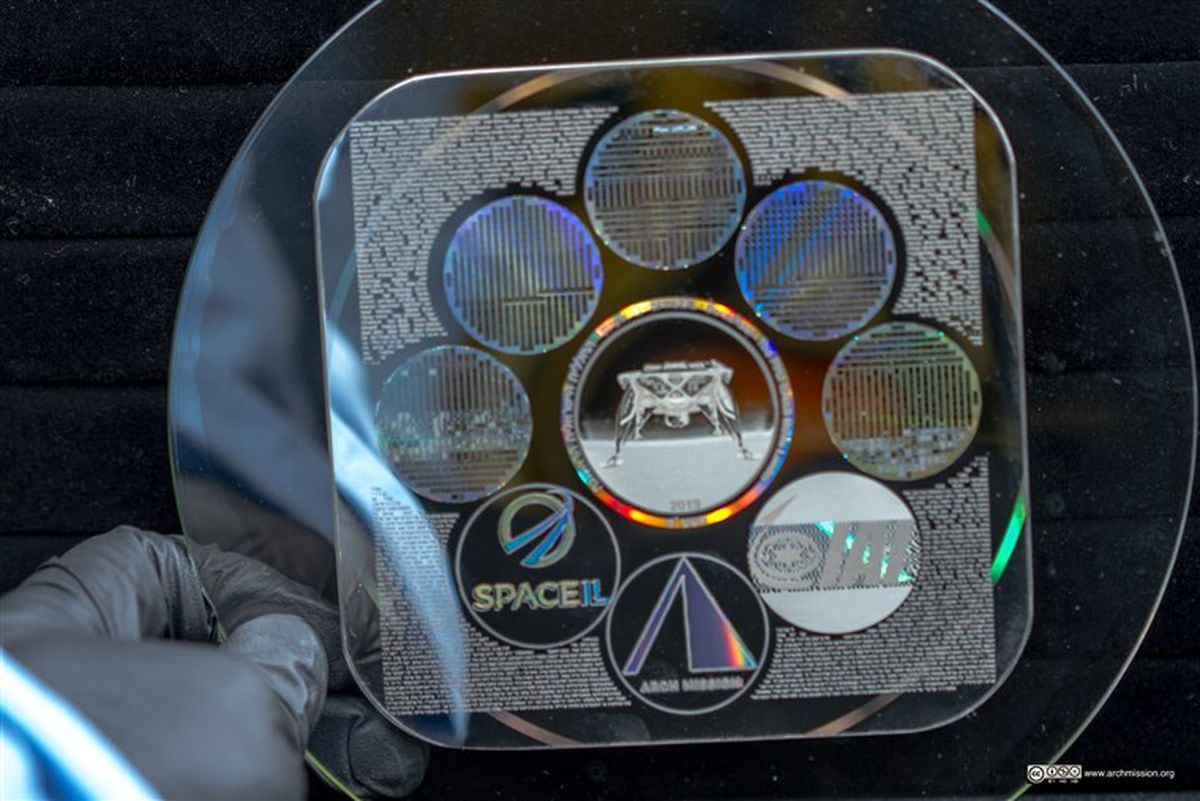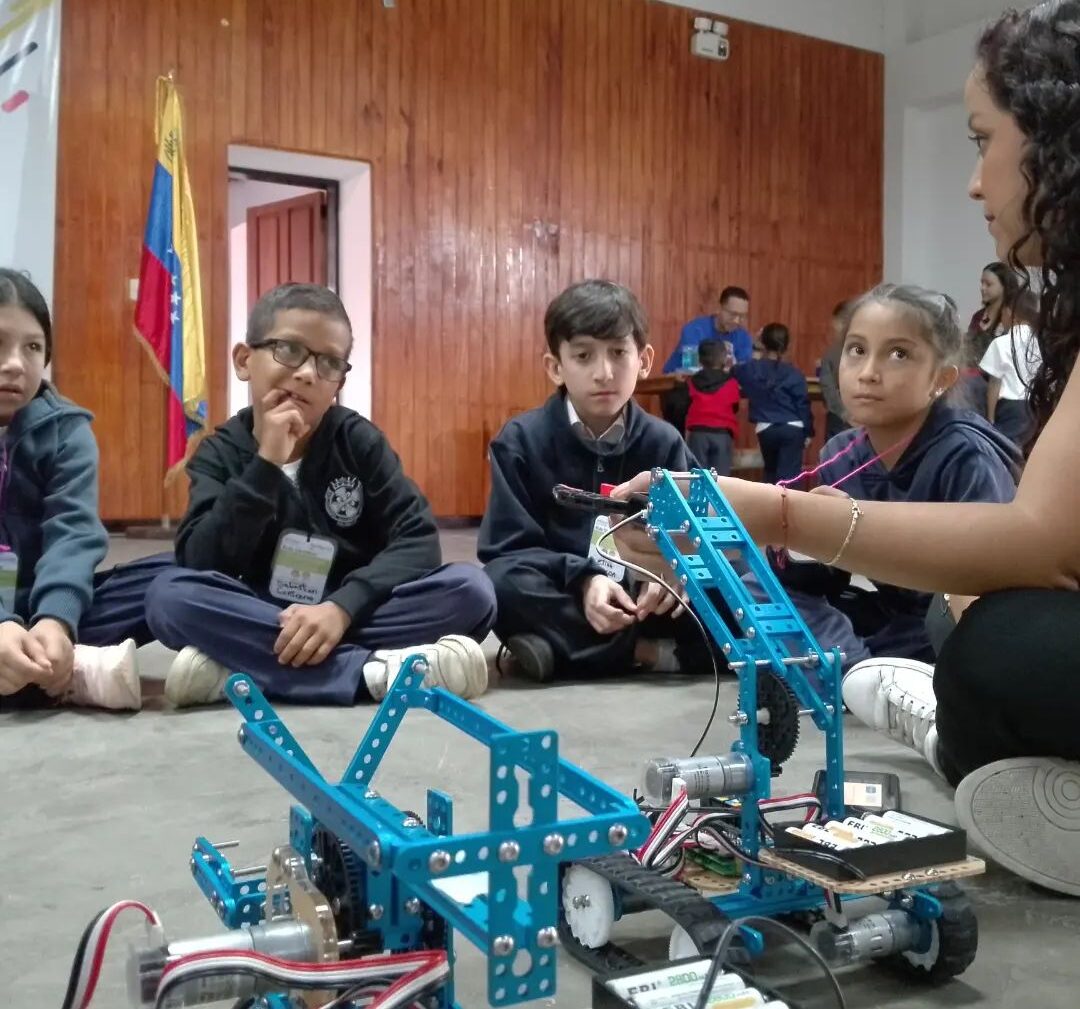On April 11, 2019, the ship Beresheet Crashed on the plain of Mare Serenitatis. It was a vehicle built on a private initiative. If it had succeeded, Israel would have been the fourth country to achieve this goal Landing on the moonAfter Russia, the United States and China. But no luck. The failure of the gyroscope led to a series of accidents in the ship's software, causing the engine to shut down at an altitude of 10 kilometers above the ground, and although it was able to start again later, the vehicle crashed into the terrain at a speed of about 700 kilometers per hour.
Being primarily an engineering test, the science load was limited, just a few instruments. Next to them was a celebratory package consisting of a DVD on which was recorded a series of documents, from the Torah to the history of Israel, its declaration of independence, and a copy of the English version of Wikipedia.
The making of the disc was an initiative of the Arch Mission Foundation, an organization dedicated to preserving the long-term memory of human culture. For millions of years, without going any further. Their policy consists of scattering samples of civilization throughout the universe in the hope that when we or our planet disappears, there will at least be evidence of our existence that future civilizations can collect. More or less, like a painting pioneer Or disks that move in VoyagerBoth are Carl Sagan's idea but on a more ambitious scale.
an experience Beresheet This was not the first initiative for this institution. He had previously digitized Isaac Asimov's Foundation trilogy and convinced Space And in a calculated propaganda coup, that burden was specifically Elon Musk's red Tesla convertible. Your browser screen showed just this phrase Do not panicanother reference to The Hitchhiker's Guide to the Galaxy, the cult work of Douglas Adams. The Asimov disc was in the glove compartment.
Another initiative placed a version of Wikipedia on a nanosatellite in Earth's orbit. That was in October 2018, on board a Chinese rocket.
New miniaturization technology
The disk that was sent to the moon on board the Israeli spacecraft known as Lunar Library It was just part of a larger project aimed at implanting replicas in the solar system. They say it is the only way to ensure their survival over millions or billions of years.
Being an object that was supposed to go to the Moon, it faced serious size and weight restrictions. They opted for the familiar look of a DVD, made not of plastic, but of 25 layers of pure nickel, each just 40 microns thick. They form a compact package, but if necessary they can be separated. In total, the disk weighs about one hundred grams, on which 30 million pages of text and images are collected, as well as audio, video and binary data files.
Of course, the real problem was not ensuring its durability, but how to store that information so that it could be read in the future by recipients, which we will never know. Digitizing it is not the answer, as those of us who still have a 5 (or, worse, 8) inch floppy disk know well. Or old cassette tapes. Simply put, there is hardly any device that can read them. And much less, the necessary software.
Analog vs digital
The Arch Foundation decided to use analog techniques. That is, pictures. Any future reader with a sense of sight similar to ours should be able to read and interpret it, as long as his or her technological level is similar or higher. Communities that had not yet reached that stage were not the intended audience for the Lunar Library, nor were they supposed to be extraterrestrials communicating through other senses.
The album cover and its next three layers hold 60,000 pages of photographic reproductions. It is possible to read them using a simple microscope with 100 times the power, a technology that should be within the reach of any fairly advanced civilization (and it has been available to us on Earth for more than four centuries).
The content of these four layers is a series of detailed instructions on how to access the rest of the information, which is digitized in DVD format. A total of 100 compressed gigabytes corresponds to about thirty million pages of text, audio, video, and binary data files. The content is very eclectic: from world literary works to explanations of David Copperfield's tricks or ancient Vedic texts.
The disc was protected by a hard case, which was located inside the car's body. This would keep him reasonably safe from the ravages of time, even if the landing was a little harder than expected.
Almost all civilizations have left messages for future generations, some more successful than others. Egyptian inscriptions can be read five thousand years later; And Roman inscriptions on their monuments as well. Medieval manuscripts have survived for a thousand years; The most delicate paper only lasts for a few centuries.
Very long-term conservation problems
Much of the vast amount of digital information we have produced in recent times is more fragile, because it is stored on plastic media whose lifespan is, at best, measured in decades. Do you remember the computer mouse that has become so popular from day to day? sticky touches? The plastic in its housing has probably begun to depolymerize.
What is even more dangerous is that to recover this information, special equipment is needed. A tablet with cuneiform letters, a medieval palimpsest, and a Baroque painting are instantly accessible just by looking at them (and knowing the language, of course); PDF document, no.
A fairly common medium for long-term storage is microfiche. It uses photographic technology and allows for a relatively low information density of up to one page per square centimeter. Their theoretical lifespan is estimated at several centuries, as long as they are preserved under controlled environmental conditions. In practice, it is difficult to guarantee it for more than 50 to 100 years.
The techniques used to manufacture the lunar disk provide much greater storage capacity and durability. Since nickel is stable, resistant to oxidation, and does not undergo radioactive decay, this material should remain unchanged for millions of years. The disc contains a large portion of our knowledge as a legacy for future generations who may or may not be our descendants. Or arrives from other planets.
Now, once you have all this collection assembled, the issue is where to store it to protect it while making it available one day. The possibility of burying copies of them in abandoned mines, under the sea, or even in deeper layers is being studied, in the hope that future developments in geology will push them to the surface. Ocean Hills don't seem like a good place if we want to prevent the library from ending up submerged in the Earth's mantle. Although the simplest option is probably space, perhaps installed at a Lagrange point or on the Moon, like the monolith in the movie 2001. In fact, the operation with Prichet was a first attempt in this sense.
Another is whether its future recipients will know how to discover it, recognize it, and benefit from its contents. The disc's contents include a kind of rosette, with a visual dictionary of seven thousand languages, with multiple alphabets and grammars to aid in the interpretation of texts. But this does not mean that teaching English to a being from the future is an easy task. Maybe that's not even possible.
It is possible that a pre-technological society that finds the library will inadvertently destroy it. Although they are highly resistant to the passage of time, nickel discs scratch easily and are not immune to good stone. Promoters of the project claim that its mere appearance – iridescent metal circles, filled with symbols incomprehensible to the naked eye – may turn it into an object of worship, and for that very reason, it protects itself from accidental or deliberate vandalism.
The best defense, they say, may be to spread the product. He left many copies in many places. Some are obvious and easy to find; Others are hidden and inaccessible. Even then, there are no guarantees that anyone will find a copy of him, nor that it will be human or post-human. They joke that the worst case scenario is that it was found by a telepathic cephalopod alien who feeds on nickel and considers the disc good candy.
Controversial bioburden
All of these plans were torpedoed – literally – upon investigation Beresheet It crashed onto the moon's surface at a speed of more than 700 kilometers per hour. Someone calculated that the energy developed was equivalent to approximately thirty kilograms of TNT. No one can say with certainty whether the library has survived in one piece or in a thousand pieces, although project promoters point out that, in the worst case, the analog pages would still be readable in each of the parts. Therefore, they believe that Israel was able to place the first global library or the first archaeological ruin on the surface of the moon.
Another, more controversial issue concerns its last-minute inclusion: a human tissue sample and a small colony of tardigrades embedded in a layer of resin. These tiny insects (less than half a millimeter in size) are known for their exceptional resistance to the harshest conditions. They can enter a state of torpor that allows them to survive at the temperature of liquid nitrogen, in boiling water, in the vacuum of space or in dry environments.
The idea was to keep these samples inside the probe, next to the disk, but the disastrous end of the mission means they may have been ejected and are now resting on Serenitatis' land, waiting for better weather to restore their activity. Specialists say it is highly doubtful that they would be able to survive cosmic rays and the constant barrage of ultraviolet rays emitted by the sun. But despite this, doubts remain. Who knows whether the purpose of the experiment was achieved or not, and millions of years later some extraterrestrial archaeologist recovers them and classifies them as valid representatives of the now extinct humanity.
You can follow Theme in Facebook, s And Instagramor sign up here to receive Our weekly newsletter.





